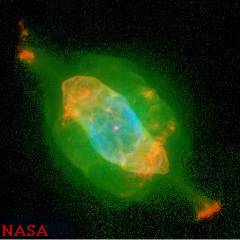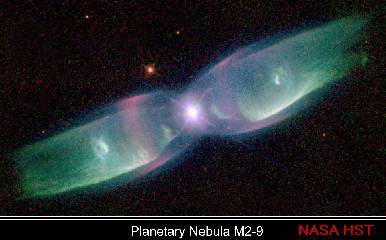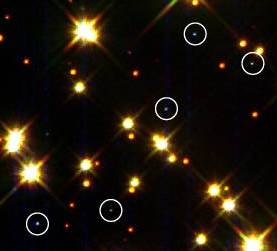|
E. The variable stage
When some 14 billion years have passed for a star like our sun, it will
become a long period (month to a year long) pulsating variable  and
its pulses and
its pulses
 become stronger
and stronger and eventually it ejects its outer layers in a giant shell
of gas, a planetary nebula. It also loses a lot of its mass in a
strong solar wind. At the end of the variable stage fusion quits for good. become stronger
and stronger and eventually it ejects its outer layers in a giant shell
of gas, a planetary nebula. It also loses a lot of its mass in a
strong solar wind. At the end of the variable stage fusion quits for good.
Death of low mass stars
 The remnant of
any giant with less than 1.4 solar masses will shrink into a rapidly spinning
star corpse about the size of the earth (3-10,000mi), a white dwarf.
Typically they mass 0.5-1 solar mass. Being as small as they are,
densities of matter in a dwarf star are enormous, a million times more
dense than water (.1-10 tons/cm3). Matter has been so compressed
that its electrons are nearly touching, and the repulsion of the like charges
prevents matter from being compressed further. We call this degenerate
matter. Even though fusion reactions are no longer taking place in dwarf
stars, for a while they will still radiate (glow) from their accumulated
heat. Over billions of years, as they cool, they fade and disappear from
sight to become black dwarfs. The remnant of
any giant with less than 1.4 solar masses will shrink into a rapidly spinning
star corpse about the size of the earth (3-10,000mi), a white dwarf.
Typically they mass 0.5-1 solar mass. Being as small as they are,
densities of matter in a dwarf star are enormous, a million times more
dense than water (.1-10 tons/cm3). Matter has been so compressed
that its electrons are nearly touching, and the repulsion of the like charges
prevents matter from being compressed further. We call this degenerate
matter. Even though fusion reactions are no longer taking place in dwarf
stars, for a while they will still radiate (glow) from their accumulated
heat. Over billions of years, as they cool, they fade and disappear from
sight to become black dwarfs.
|





